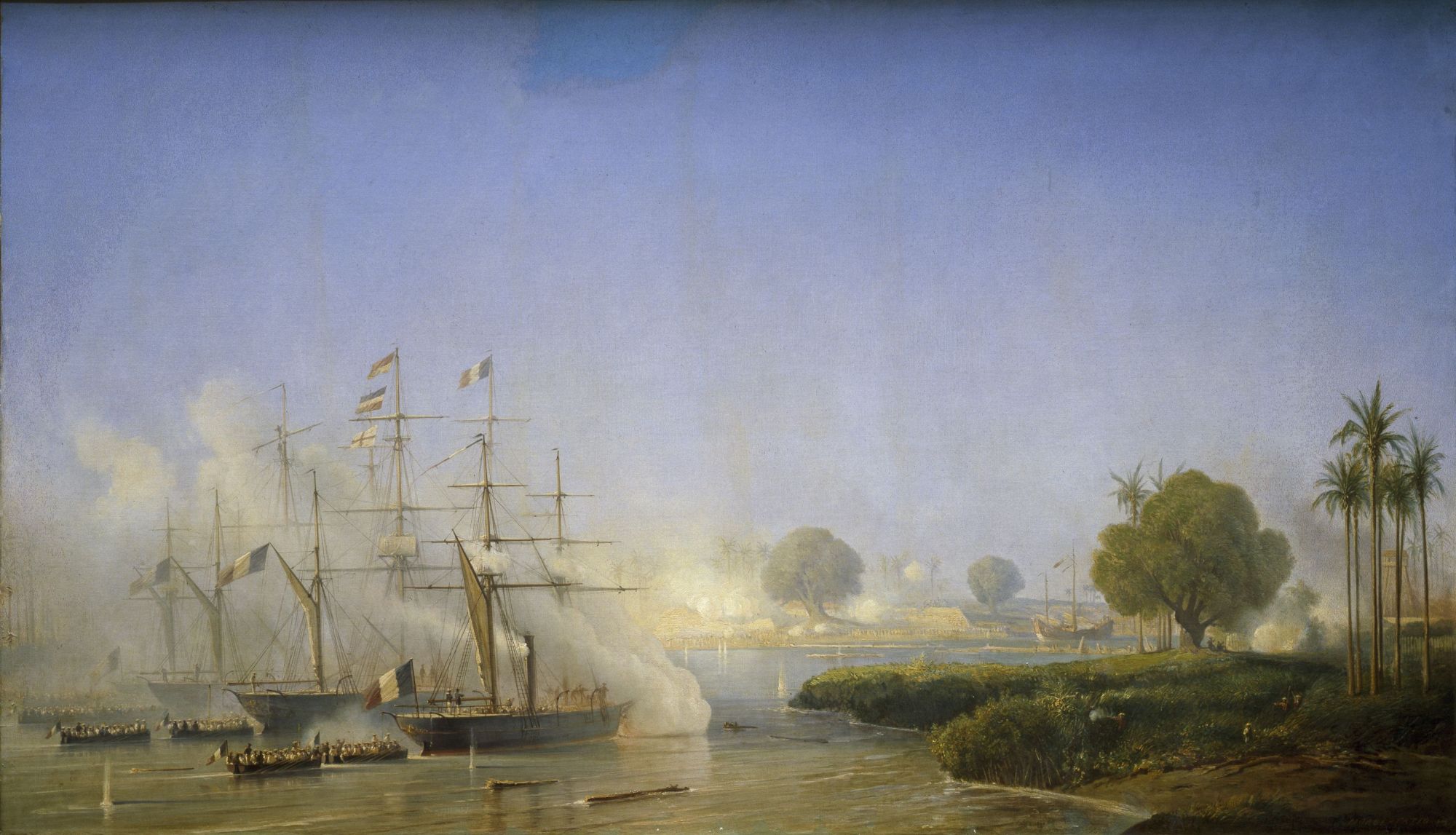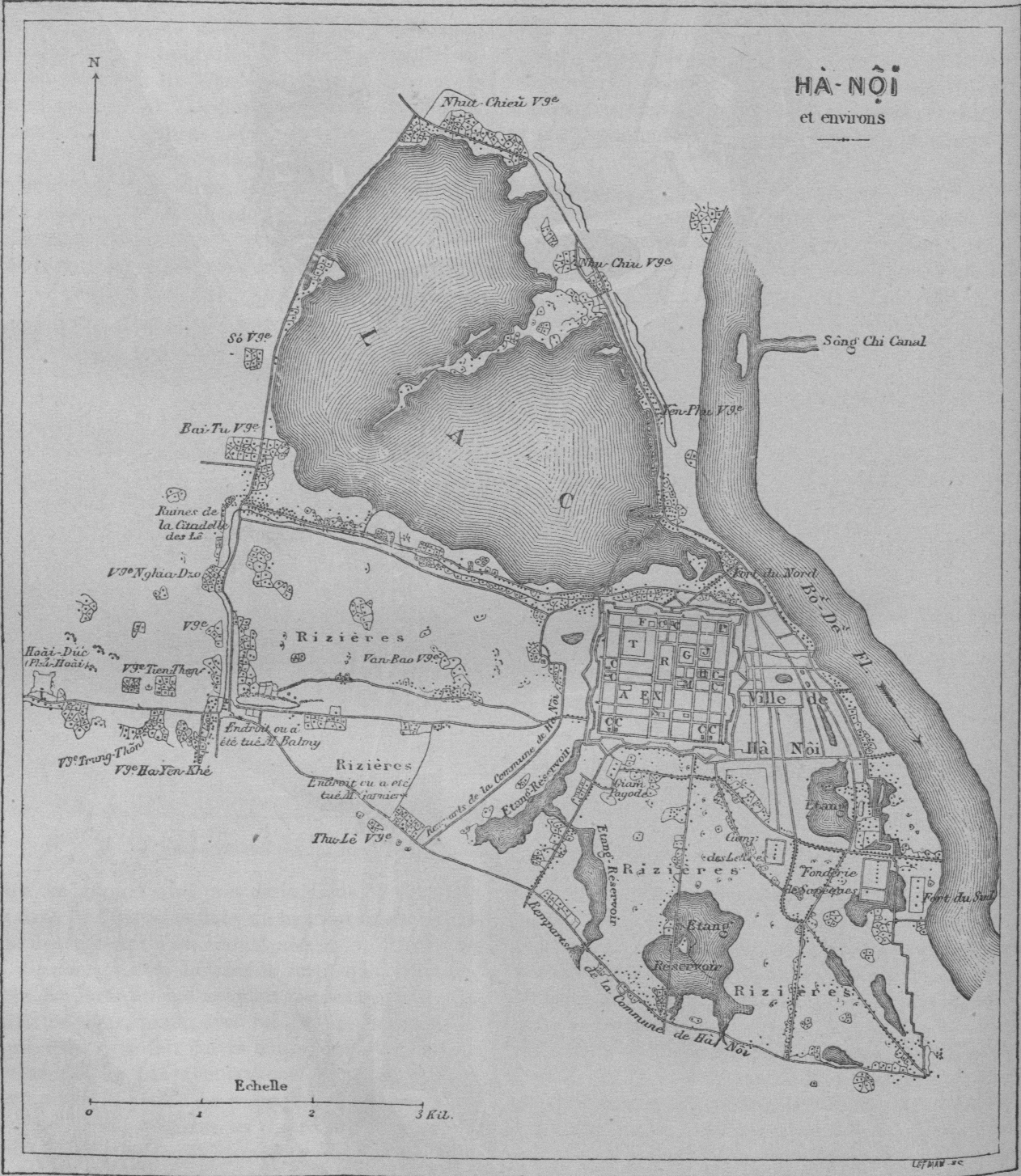|
Tonkin Expedition
The Tonkin campaign was an armed conflict fought between June 1883 and April 1886 by the French against, variously, the Vietnamese, Liu Yongfu's Black Flag Army and the Chinese Guangxi and Yunnan armies to occupy Tonkin (northern Vietnam) and entrench a French protectorate there. The campaign, complicated in August 1884 by the outbreak of the Sino-French War and in July 1885 by the Cần Vương nationalist uprising in Annam (central Vietnam), which required the diversion of large numbers of French troops, was conducted by the Tonkin Expeditionary Corps, supported by the gunboats of the Tonkin Flotilla. The campaign officially ended in April 1886, when the expeditionary corps was reduced in size to a division of occupation, but Tonkin was not effectively pacified until 1896. Hanoi and Nam Định (June–July 1883) Nine years after Francis Garnier's unsanctioned attempt to conquer Tonkin was cut short by the French government, French and Vietnamese troops clashed in Tonkin ... [...More Info...] [...Related Items...] OR: [Wikipedia] [Google] [Baidu] |
French Conquest Of Vietnam
The French conquest of Vietnam (1858–1885) was a long and limited war fought between the Second French Empire, later the French Third Republic and the Vietnamese empire of Đại Nam in the mid-late 19th century. Its end and results were victories for the French as they defeated the Vietnamese and their Chinese allies in 1885, the incorporation of Vietnam, Laos, and Cambodia, and finally established French rules over constituent territories of French Indochina over Mainland Southeast Asia in 1887. A joint Franco-Spanish expedition attacked Da Nang in 1858 and then retreated to invade Saigon. King Tu Duc signed a treaty in June 1862 granting the French sovereignty over three provinces in the South. The French annexed the three southwestern provinces in 1867 to form Cochinchina. Having consolidated their power in Cochinchina, the French conquered the rest of Vietnam through a series of battles in Tonkin, between 1873 and 1886. Tonkin at that time was in a state of near anarchy, d ... [...More Info...] [...Related Items...] OR: [Wikipedia] [Google] [Baidu] |
Tonkin Expeditionary Corps
The Tonkin Expeditionary Corps (french: corps expéditionnaire du Tonkin) was an important French military command based in northern Vietnam (Tonkin) from June 1883 to April 1886. The expeditionary corps fought the Tonkin Campaign (1883–86) taking part in campaigns against the Black Flag Army and the Chinese Yunnan and Guangxi Armies during the Sino-French War (August 1884–April 1885) and the period of undeclared hostilities that preceded it (August 1883–June 1884), and in important operations against Vietnamese guerrilla bands during the subsequent 'Pacification of Tonkin' (May 1885–February 1886). Commanders and campaigns General Alexandre-Eugène Bouët (1833–87) The expeditionary corps was established in June 1883 in the wake of Henri Rivière's defeat and death at the Battle of Paper Bridge, to entrench the French protectorate in Tonkin. Its first commander was ''général de brigade'' Alexandre-Eugène Bouët (1833–87), the most senior marine infantry of ... [...More Info...] [...Related Items...] OR: [Wikipedia] [Google] [Baidu] |
Admiral Courbet In Hue
Admiral is one of the highest ranks in some navies. In the Commonwealth nations and the United States, a "full" admiral is equivalent to a "full" general in the army or the air force, and is above vice admiral and below admiral of the fleet, or fleet admiral. Etymology The word in Middle English comes from Anglo-French , "commander", from Medieval Latin , . These evolved from the Arabic () – (), “king, prince, chief, leader, nobleman, lord, a governor, commander, or person who rules over a number of people,” and (), the Arabic article answering to “the.” In Arabic, admiral is also represented as (), where () means the sea. The 1818 edition of Samuel Johnson's ''A Dictionary of the English Language'', edited and revised by the Rev. Henry John Todd, states that the term “has been traced to the Arab. emir or amir, lord or commander, and the Gr. , the sea, q. d. ''prince of the sea''. The word is written both with and without the d, in other languages, as well ... [...More Info...] [...Related Items...] OR: [Wikipedia] [Google] [Baidu] |
New Caledonia
) , anthem = "" , image_map = New Caledonia on the globe (small islands magnified) (Polynesia centered).svg , map_alt = Location of New Caledonia , map_caption = Location of New Caledonia , mapsize = 290px , subdivision_type = Sovereign state , subdivision_name = , established_title = Annexed by France , established_date = 24 September 1853 , established_title2 = Overseas territory , established_date2 = 1946 , established_title3 = Nouméa Accord , established_date3 = 5 May 1998 , official_languages = French , regional_languages = , capital = Nouméa , coordinates = , largest_city = capital , demonym = New Caledonian , government_type = Devolved parliamentary dependency , leader_title1 = President of France , leader_name1 = Emmanuel Macron , leader_title2 = President of the Government , leader_name2 = Louis Mapou , leader_title3 = President of the Congress , leader_name3 = Roch Wamytan , leader_title4 = High Commissioner , leader_name4 = Patrice ... [...More Info...] [...Related Items...] OR: [Wikipedia] [Google] [Baidu] |
Combat Of Nam Dinh 19 July 1883
Combat (French for ''fight'') is a purposeful violent conflict meant to physically harm or kill the opposition. Combat may be armed (using weapons) or unarmed ( not using weapons). Combat is sometimes resorted to as a method of self-defense, or can be used as a tool to impose one's will on others. An instance of combat can be a stand-alone confrontation or a small part of a much larger violent conflict. Instances of combat may also be benign and recreational, as in the cases of combat sports and mock combat. Combat may comply with, or be in violation of local or international laws regarding conflict. Examples of rules include the Geneva Conventions (covering the treatment of people in war), medieval chivalry, the Marquess of Queensberry rules (covering boxing) and several forms of combat sports. Hand-to-hand combat Hand-to-hand combat (melee) is combat at very close range, attacking the opponent with the body ( striking, kicking, strangling, etc.) and/or with a melee weapo ... [...More Info...] [...Related Items...] OR: [Wikipedia] [Google] [Baidu] |
Battle Of Paper Bridge
A battle is an occurrence of combat in warfare between opposing military units of any number or size. A war usually consists of multiple battles. In general, a battle is a military engagement that is well defined in duration, area, and force commitment. An engagement with only limited commitment between the forces and without decisive results is sometimes called a skirmish. The word "battle" can also be used infrequently to refer to an entire operational campaign, although this usage greatly diverges from its conventional or customary meaning. Generally, the word "battle" is used for such campaigns if referring to a protracted combat encounter in which either one or both of the combatants had the same methods, resources, and strategic objectives throughout the encounter. Some prominent examples of this would be the Battle of the Atlantic, Battle of Britain, and Battle of Stalingrad, all in World War II. Wars and military campaigns are guided by military strategy, wherea ... [...More Info...] [...Related Items...] OR: [Wikipedia] [Google] [Baidu] |
Hoàng Kế Viêm
Hoàng Kế Viêm (1820–1909) was a Vietnamese General and a Dong'ge Grand Secretariat during the Nguyễn dynasty. He played a significant role in suppressing borderlands banditry and resisting French invasion during the second half of the 19th century. Early Years Hoàng Kế Viêm (1820–1909) was a son-in-law of emperor Minh Mạng. His father is Hoàng Kim Xán, the governor of province Khánh Hòa. In the year 1841, Emperor Minh Mạng died, and his eldest son Thiệu Trị succeeded to the throne. In 1843, Hoàng Kế Viêm married Nguyễn Phúc Quang Tĩnh, the fifth daughter of Emperor Minh Mạng and thus became a Prince (Phò mã). The next year, Nguyễn Phúc Quang Tĩnh died at age 28 during pregnancy. Emperor Thiệu Trị gave her the title of Princess Hương La (Hương La Công Chúa). Military career Anti-Imperial Bandits Yanling Kingdom In 1849, Taiping Rebellion broke out by Hong Xiuquan, together with Yang Xiuqing, Xiao Chaogui and Li X ... [...More Info...] [...Related Items...] OR: [Wikipedia] [Google] [Baidu] |
Capture Of Nam Định (1883)
The Capture of Nam Định (27 March 1883), a confrontation between the French and the Vietnamese, was one of the early engagements of the Tonkin Campaign (1883–86). In a brief campaign in the last week of March 1883, Commandant Henri Rivière captured the citadel of Nam Định, the second-largest city in Tonkin, with a flotilla of gunboats and a battalion of marine infantry. Rivière's seizure of Nam Định marked a significant escalation of French ambitions in Tonkin, and had important consequences. China began to covertly support the Vietnamese government in its opposition to French colonization. Chinese involvement in Tonkin ultimately resulted in the nine-month Sino-French War (August 1884–April 1885). Background French intervention in northern Vietnam was precipitated by Commandant Henri Rivière, who was sent with a small French military force to Hanoi at the end of 1881 to investigate Vietnamese complaints against the activities of French merchants. In defian ... [...More Info...] [...Related Items...] OR: [Wikipedia] [Google] [Baidu] |
Battle Of Hanoi (1882)
The Battle of Hanoi on 25 April 1882, was the illegal capture by French naval captain Henri Rivière, acting without his superiors' orders. The French handed the city back later. The Citadel of Hanoi was almost totally unprepared and the entire attack lasted less than an hour, and ended with only four French soldiers wounded. The Nguyễn dynasty Vietnamese defenders suffered heavy losses including, at his own hand, Governor Hoàng Diệu, following the dispatch of a final message to the Emperor Tự Đức in Huế. Background When Hoàng Diệu first assumed the Governor of Hà Ninh in early 1880, he recognized the important position of Hà Nội "as the throat of Bắc Hà", and "once Hà Nội collapsed fall, the other provinces will also fall apart." The Nguyễn dynasty built Hà Nội citadel following the French Vauban style from the late 17th century. The citadel was built in a square shape with each side 1 km long. The wall was built of box bricks, the bot ... [...More Info...] [...Related Items...] OR: [Wikipedia] [Google] [Baidu] |
Henri Rivière (naval Officer)
Henri Laurent Rivière (1827–1883) was a French naval officer and a writer who is chiefly remembered today for advancing the French conquest of Tonkin (northern Vietnam) in the 1880s. Rivière's seizure of the citadel of Hanoi in April 1882 inaugurated a period of undeclared hostilities between France and Dai Nam (as Vietnam was known then) that culminated one year later in the Tonkin campaign (1883–1886). Early career Born in Paris on 12 July 1827, Rivière entered the École Navale in October 1842. He passed out as a midshipman (second class) in August 1845, and saw his first naval service in the Pacific Ocean on ''Brillante''. In February 1847 he was posted to the South Seas naval division, to ''Virginie''. He was promoted to midshipman (first class) in September 1847 and to ''enseigne de vaisseau'' in September 1849. During the next five years he served in the Mediterranean squadron aboard ''Iéna'' (1850), ''Labrador'' (1851) and ''Jupiter'' (1852–54). Signific ... [...More Info...] [...Related Items...] OR: [Wikipedia] [Google] [Baidu] |






